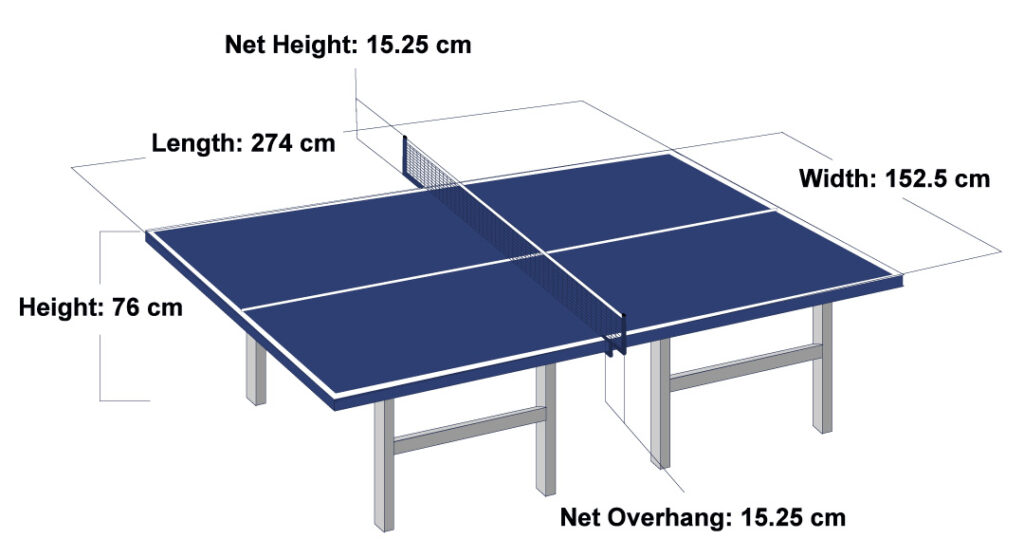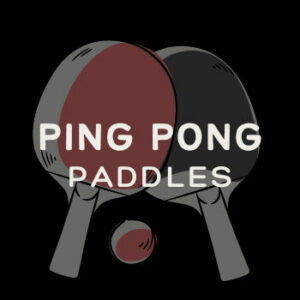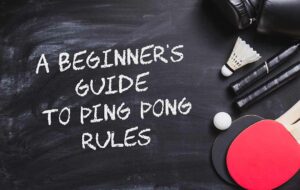Before we dive into the world of ping pong, it’s crucial to understand the rules that govern this exciting game. Just like any other sport, ping pong has a set of rules that players must follow. These rules not only ensure fair play but also add a layer of strategy and excitement to the game. In this section, we will be focusing on two main aspects:
- Understanding the basic ping pong rules
- Importance of learning the rules before playing
Understanding the Basic Ping Pong Rules
Ping pong, also known as table tennis, is a game where two or four players hit a lightweight ball back and forth using small rackets. The game takes place on a hard table divided by a net. The basics of ping pong rules are quite straightforward:
- The game starts with a serve. The server must throw the ball up at least 6 inches and hit it so it bounces on their side of the table before going over the net and bouncing on the opponent’s side.
- Each player gets to serve two points in a row and then switch server. However, if a score of 10-10 is reached in any game, then each server serves only one point and then the server is switched.
- A point is scored when a player fails to return the ball, hits the ball twice, hits the ball before it bounces on their side of the table, or fails to hit the ball over the net.
Importance of Learning the Rules Before Playing
Understanding the rules of ping pong is not just about knowing how to play the game. It’s about understanding the spirit of the game and respecting its traditions. Here’s why learning the rules before playing is important:
- Ensures fair play: By knowing the rules, you can ensure that the game is played fairly and that no player has an unfair advantage.
- Improves your strategy: Understanding the rules can help you develop a better game strategy. For example, knowing how to serve correctly can give you an advantage over your opponent.
- Enhances enjoyment: Knowing the rules can make the game more enjoyable. You’ll be able to appreciate the skill and strategy involved in each point and understand why certain decisions are made.
So, before you pick up that paddle, take some time to learn the rules of ping pong. It will not only make you a better player but also enhance your enjoyment of this wonderful game.
Beginner’s Guide to Ping Pong: The Basics
Welcome to the exciting world of ping pong! Whether you’re a newbie or an experienced player looking to brush up on the basics, this guide is just for you. Let’s dive right in!
Ping Pong Equipment
Before we start, it’s important to understand the equipment used in ping pong. The three main pieces of equipment are the table, the ball, and the paddle. Let’s take a closer look at each of these.
Table and Net Specifications
The ping pong table is rectangular, measuring 9 feet long, 5 feet wide, and 2.5 feet high. The table is divided into two halves by a net that stands 6 inches high. The table’s surface must be dark and matte to allow players to see the ball clearly.
Ping Pong Ball Characteristics
The ping pong ball is small, light, and round. It measures 40mm in diameter and weighs 2.7 grams. It’s usually white or orange, depending on the color of the table. The ball should bounce about 9 inches high when dropped from a height of 12 inches.
Ping Pong Paddle Requirements
The ping pong paddle, also known as a racket or bat, is used to hit the ball. It’s made of wood and covered with rubber on both sides. The rubber can be red or black, and it affects how the ball spins when hit. The paddle should be comfortable to hold and easy to maneuver.
Now that you know about the equipment, you’re ready to start playing! But remember, practice is key. So grab your paddle, and let’s get started!

Ping Pong Playing Rules
Let’s dive into the exciting world of ping pong rules. These rules help keep the game fair and fun for everyone. We will cover three main areas: service rules, the scoring system, and rules for doubles play.
- Service Rules
In ping pong, the server must throw the ball straight up, at least 6 inches high. The ball should be hit so it bounces on the server’s side first, then the opponent’s side. If the ball touches the net but still lands in the opponent’s area, it’s called a let serve and the server gets to serve again. But if the ball hits the net and doesn’t reach the opponent’s side, the server loses a point.
- Scoring System
Ping pong uses a point system to determine who wins. A match is typically played best of 5 or 7 games. For each game, the first player to reach 11 points wins that game, however, a game must be won by at least a two point margin. A point is scored after each ball is put into play (not just when the server wins the point as in volleyball).
- Rules for Doubles Play
In doubles play, the rules change a bit. The service still needs to bounce on the server’s side first, but it must land in the opposite side of the table on the opponent’s side. After the serve, players must take turns hitting the ball. For example, if player A serves, player B will return, then player A’s partner will hit, and so on. It’s like a fun dance of ping pong!
Understanding these rules can help you enjoy the game of ping pong even more. Remember, the most important rule is to have fun!
Understanding Ping Pong: Advanced Rules
As you become more skilled in ping pong, it’s important to understand the more advanced rules. These can be tricky, but they are crucial for playing the game correctly and fairly. Let’s dive into some commonly misunderstood rules.
Commonly Misunderstood Rules
Here are three rules that often confuse players:
- Edge Ball Rule
The edge ball rule is one that can cause a lot of debate during games. If the ball hits the edge of the table, it’s considered in play. This means that if the ball hits the edge and then bounces off, the point continues. It’s a tricky rule because the ball can bounce in unpredictable ways when it hits the edge, making it hard to return.
- Double Hit Rule
The double hit rule is another one that can cause confusion. If a player hits the ball twice in a row, it’s considered a double hit and the point is lost. However, if the ball hits the player’s paddle and then their body or hand holding the paddle, it’s not considered a double hit. This is because the player didn’t make a separate motion to hit the ball a second time.
- Net Serve Rule
The net serve rule is often misunderstood by beginners. If the ball hits the net on a serve but still lands in the opponent’s service box, the serve is considered good and the point continues. This is called a “let” serve. If the ball hits the net and doesn’t land in the service box, the serve is a fault.
Understanding these advanced rules can help you become a better ping pong player. They may seem complicated at first, but with practice, you’ll be able to navigate them with ease.

Penalties and Disqualifications
Just like any other sport, ping pong also has penalties and disqualifications. These rules are in place to ensure fair play and good sportsmanship. Let’s take a closer look at some of these penalties.
- Unsportsmanlike conduct
Unsportsmanlike conduct is a serious offense in ping pong. This could include actions such as shouting at the opponent, refusing to shake hands, or arguing with the referee. These actions can lead to penalties or even disqualification. Remember, good sportsmanship is just as important as skill in ping pong.
- Illegal serves
An illegal serve in ping pong can result in a point for the opponent. Some examples of illegal serves include hiding the ball during the serve, not throwing the ball high enough, or serving before the opponent is ready. It’s crucial to understand and follow the serve rules to avoid these penalties.
- Equipment tampering
Equipment tampering is another serious offense in ping pong. This could involve altering the ping pong paddle in a way that gives an unfair advantage, such as applying extra glue to the rubber. If caught, the player could be disqualified. Always play fair and respect the equipment rules.
In conclusion, understanding and following the rules of ping pong is essential for every player. Not only does it ensure fair play, but it also enhances the enjoyment of the game for everyone involved. So, always remember to play fair, respect your opponent, and most importantly, have fun!
Mastering Ping Pong: Strategies and Techniques
When it comes to mastering ping pong, understanding the right strategies and techniques is key. Whether you’re a beginner or an experienced player, there are always new skills to learn and strategies to try. Let’s start with some basic strategies for beginners.
Basic Strategies for Beginners
As a beginner, your focus should be on learning the basics. Here are some strategies that can help you improve your game:
- Serving Techniques
Serving is the first step in any ping pong game. It’s important to have a good serve to start the game on a strong note. Try different types of serves like the backspin, topspin, and sidespin. Practice your serves regularly to improve your accuracy and speed.
- Defensive Strategies
Defense is just as important as offense in ping pong. Learn how to block and return your opponent’s shots effectively. Remember, the goal of defense is not just to keep the ball in play, but also to set up your own offensive shots.
- Offensive Strategies
Offense is about making aggressive shots to score points. Learn how to hit the ball with power and precision. Try different offensive shots like the smash, drive, and loop. Remember, a good offensive strategy involves a mix of power and placement.
These are just the basics. As you gain more experience, you can start to learn more advanced strategies and techniques. Remember, the key to mastering ping pong is practice and persistence. So keep playing, keep learning, and most importantly, have fun!

Advanced Techniques for Improving Your Game
Now that you’ve mastered the basics, it’s time to take your ping pong game to the next level. Here are some advanced techniques that can help you improve your game.
- Spin Techniques
Adding spin to your shots can be a game-changer. There are three main types of spin: topspin, backspin, and sidespin. Topspin is when the ball spins forward, making it dip down onto the table. Backspin, on the other hand, makes the ball bounce less and can trick your opponent into hitting the ball into the net. Sidespin can make the ball curve in the air, making it harder for your opponent to hit.
Mastering these spins can give you a significant advantage in the game. It’s all about the angle of your paddle and the timing of your swing. Practice makes perfect!
- Footwork and Positioning
Good footwork is crucial in ping pong. It allows you to move quickly and get into the best position to hit the ball. Remember, it’s always easier to hit the ball when it’s in front of you rather than on the side.
Try to stay on your toes and move your feet quickly. Don’t just use your arms to hit the ball; use your whole body. This will give you more power and control over your shots.
- Reading Your Opponent’s Play
One of the most important skills in ping pong is being able to read your opponent’s play. This means predicting where they’re going to hit the ball based on their body language and the position of their paddle.
Pay close attention to your opponent’s serving habits and their preferred shots. This can give you a clue about what they’re going to do next. Remember, the best defense is a good offense!
Mastering these advanced techniques can take your ping pong game to new heights. So grab your paddle, get out there, and start practicing!
Conclusion: The Importance of Understanding Ping Pong Rules
As we wrap up our discussion on ping pong rules, it’s crucial to understand the importance of the game’s rules. Knowing the rules is not just about avoiding penalties or disputes during a match. It’s about elevating your game to the next level and truly mastering the art of ping pong.
- How understanding the rules can improve your game
Understanding ping pong rules can significantly improve your game. It helps you strategize better, make smart decisions, and gain an edge over your opponent. For instance, knowing the service rules can help you serve in a way that makes it difficult for your opponent to return. Similarly, understanding the scoring system can help you plan your game better. It’s like a chess player knowing the moves – it’s a game-changer!
- Next steps after mastering the beginner’s ping pong guide
Once you’ve mastered the basics, it’s time to move on to advanced strategies and techniques. This includes learning different types of serves, returns, and spins. You can also start participating in local tournaments to gain experience and improve your skills. Remember, practice makes perfect. So, keep practicing and keep improving!
In conclusion, understanding the rules of ping pong is like having a roadmap to success. It guides you on how to play the game, what to avoid, and how to strategize. So, keep learning, keep practicing, and most importantly, keep enjoying the game. Happy playing!



